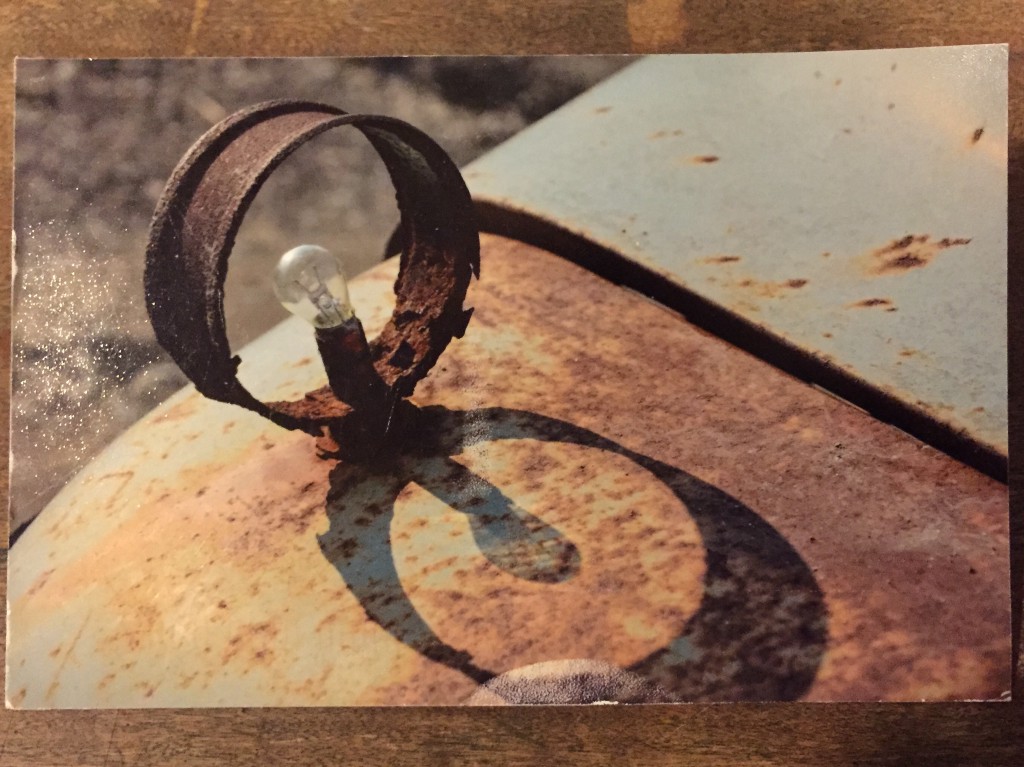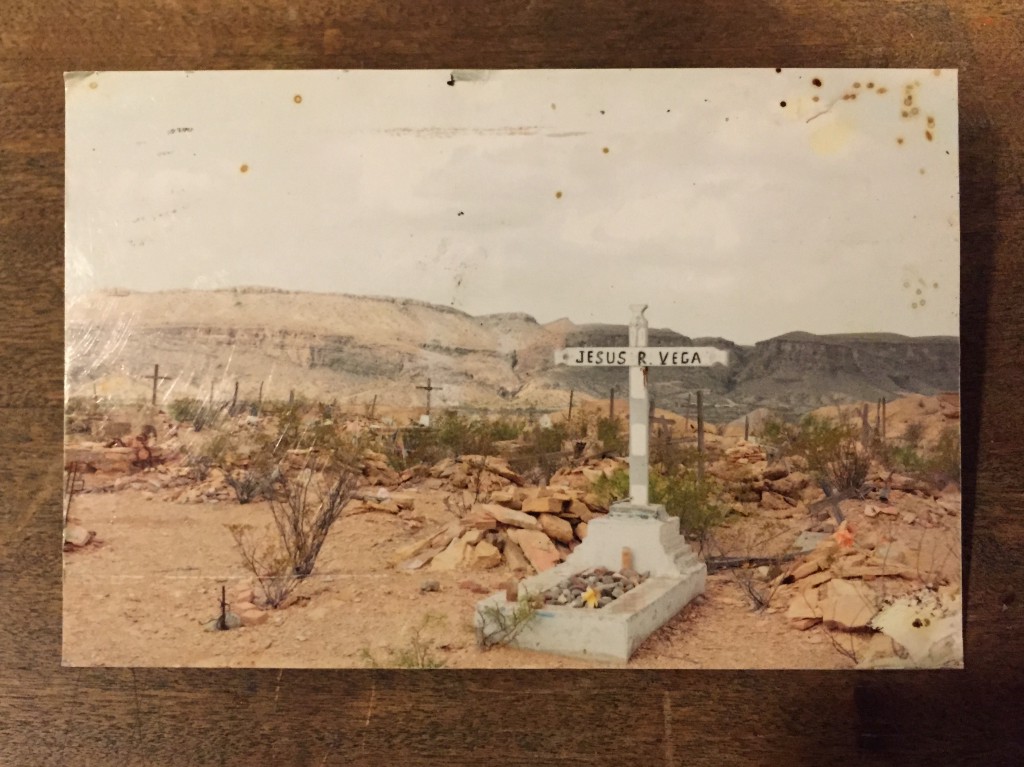A Poem by Joyelle McSweeney
by Mark Bibbins, Editor
Hellebore
1.
run it again
double the charge
what’s the damage
sign for it
the universe wheels around in its dishevelment
like an afternoon drunk
rolls a wild eye which is a loophole
everything crawls out or goes in after it
this endtime’s gonna last awhile
a cartoon toucan flies through the chemo suite
dripping sugar loops from its beak
it’s on life support, on repeat
its ink flows antigravitational
flinks from its flank
both a ballpoint pen and a butane lighter
also useful for tracheostomy
an astronaut writes a cheque
a digital door swings open
debt falls out like breasts from the cargo bay
inside the jumpsuit
a port fails
starving bears revolve on ice floes
the nest of ivs snakes like a flexible crown
take it out on the holidays
write back from the front
I am quite well/in hospital
send that lotion I like
my hat is jumping out of my brain
my groin joists groan in the wind
pigeonhole egghole hammer staples my skull
carts around a trunkload of busted audio equipment
I can’t excise
onion scapes
do something remarkable in the dark
only grow away
grow through everything
like toenails in the grave
point the way
demolish
is a word I learned from my mickey mouse dictionary:
the greenhouse is demolished
a political word
a representation of donald duck’s anger
in denmark his name is anders and
anders and
a feathered fist
anders and
a convulsive contract
anders and a general contractor
anders and like a universe
slashes his own greenhouse
and anger
fangs the rose
with glass
2.
the rose
who has been quietly manufacturing her own fangs
now wears a diadem of damage on the upended tubs
of fungicide and bone meal
if you label it ‘poison’ they will use it to kill themselves
because they love to read labels
and use things
those humans
and want to drown in the sea
of the Internet
like Freud said
luckless civilians
citizen army
spirit level in the pitted brain
kill me with the farming equipment
kill me with that ashbery poem
farm implements and rutabagas in a landscape
the British call them swedes
carve them up and put a candle there
on the face a chancre grows
a chancre of light
a sad sarcoma
that sags from the wink
fagged out
like fruit loops the beak of a toucan
or fish hooks the mutilated pelican
the hard ‘c’ catches the breath and throws it back
the hard ‘o’ sucks the exhaust pipe of industry
its lipstick is made of arsenic
leached from lead tailings
left over from a mining operation
and adorns the headless mountain with bright pools
we call that rigor mortis because it has such ethical rigor
like simone weil’s heartwall breaking down becoming broth
to feed the rest of the starving body
when the teenager seizes in the driveway, her hatchback
glides down into traffic on its own
its precious stew of heartwall leaching into the bloodstream
this poem forgot to be good
that teenager forgot not to die
those two girls in Uttar Pradesh probably hung themselves
that mango tree colluded
that mango tree forgot to be ethical
listing its face
towards a corona
it was trying to see around
it was trying to see around its burden
it was trying to blink out its blastoma
it was trying to comb the hair of the comet from
inside its sclera, uvea and retina
where its bloodwalls were branching in its eyes
its trunk turning to stone
who streaks the sky
with her long hair out behind
what prodigy
and besides
who gapes
who gags
who knifes open a gut to study what’s clutched there
lets empty out the ocean
to store our plastic beads there
razor handles, mylar balloons
and other indigestibles:
the fear of being a bad poem
the fear of a sole that would crush the palisade layer
the fear of a truncheon that would smash down the facebones
those onion domes and slender minarets
the fear of a bullet that would mark all the chests
with its redline, its markdown, its infinitesimal expense
Joyelle McSweeney’s Dead Youth, or, The Leaks, a verse play starring Julian Assange on the high seas, is out now from Litmus Press.
You will find more poems here. You may contact the editor at poems@theawl.com.
New York City, December 17, 2014
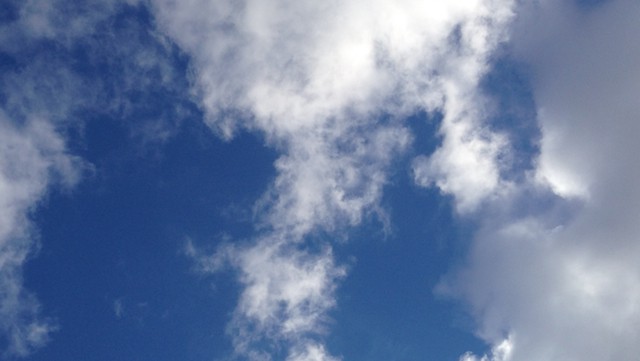
★★★★ Puffy white-and-gray clouds were gathering in the west and moving eastward against a gentle blue sky. The sun shone up Broadway onto the taxis and the taxi-colored cases of the crosswalk signals. It was possible to remember that the steel drum playing “O Come, All Ye Faithful” was capable of signifying the tropics and not merely the subway platform. Overhead, downtown, the clouds bridged the rooftops; off above Lower Manhattan they were dense, with an intense glow seeping between them. Red roses and other spilled garbage lay crushed in the gutter. The breeze put a gentle chill on the jaw hinge and earlobes. There couldn’t be a whole day’s worth of this, and there wasn’t: the clouds closed over the afternoon, shutting the light off even earlier than early. The cold after dark had a pinch to it, leaving fingers and thumb tips feeling raw.
The Internet's Wine
by Betsy Morais
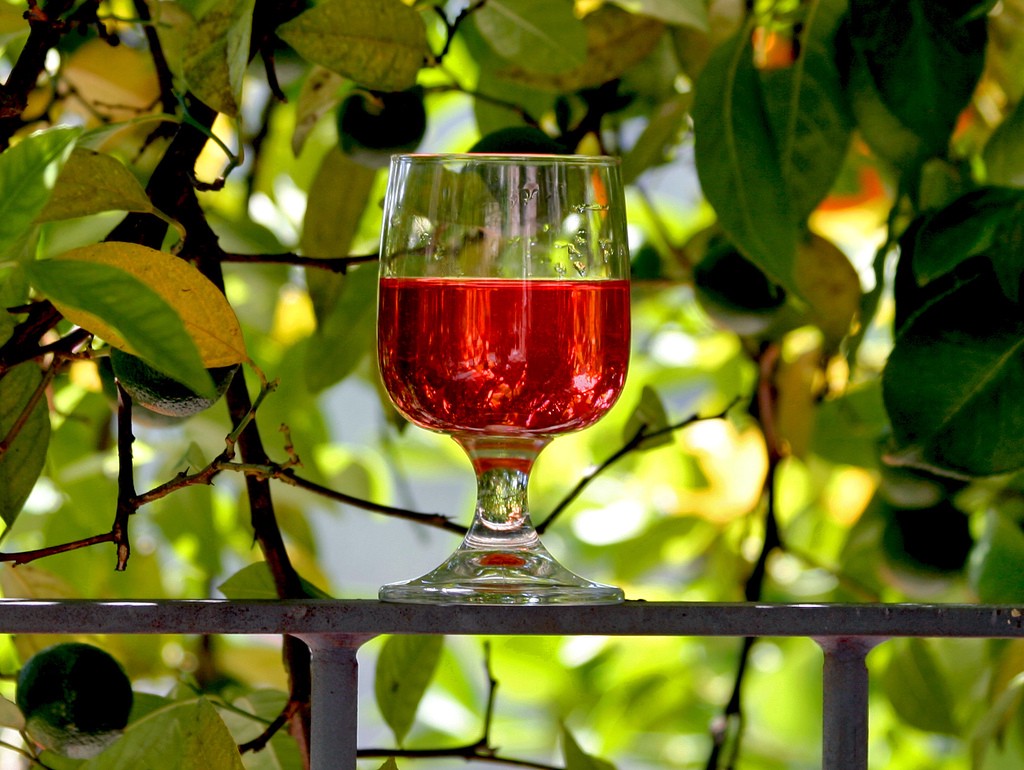
Snobbery may be nearly dead: The Brandenburgs are big on YouTube; ballet sells undershirts; and winemaking has been crowdsourced. “There’s no right or wrong way to transform a bucket full of grapes into wine,” Juan Muñoz Oca, the head winemaker at Columbia Crest, a Washington-state vineyard, told me the other night. “There’s just maybe the way that you would like to see them.”
Muñoz Oca, dressed as the aesthete, wore a sharp black suit, a lavender shirt, and a neatly folded turquoise-and-purple pocket square. At his ankles, a more experimental touch: gray socks with orange and magenta squiggly stripes. “When I get talking and really dive in deep to the nuances of the process, I get geeky, like, in no time,” he said. “And people are, like, ‘I really don’t know what you’re talking about!’” Wine is for sniffers, swirlers, tannin inspectors — people with a nose for detail and the funds to support the burden of discerning taste. Those who run the vineyards are the keepers of mystery, enabling the conceit that acquired knowledge — experience itself, one might say — can be sipped upon and make you tipsy with rarefied pleasure. Still: Thomas Jefferson — wine collector, Bordeaux admirer, American president though he may have been — failed to produce Cabernet at Monticello; the feet-crushers have long persisted. So Muñoz Oca decided to share the mantle with anybody who’s got an Internet connection and an opinion: CrowdsourcedCabernet.com is a vote-for-your-vino system that, starting in August, began to call upon the masses to dabble in the domain of the genteel.
To prove his dedication, Muñoz Oca came to meet the people on their turf, by paying a first-time visit to the MLB Man Cave, in downtown Manhattan. He stood beside a banquet table and gestured underneath, at a stump of gnarled roots and dead leaves: whence the wine came. “This one was sacrificed,” he said. Every few years, the winery will pluck some vines out of the ground and inspect the insides — a check-up that necessitates the death of the specimen. He had put a few on display. “I couldn’t use them any more, so I brought them with me.” Wine was poured and a crowd gathered at the table. Guests — guys, mostly — sipped from plastic cups and milled around in a vast room that also contained a gigantic surfboard and a very serious-looking motorbike.
“I’ve never done anything other than wine,” Muñoz Oca told me. “I grew up on a winery.” His grandfather and his father taught him the business. “For them, it was very important to expose me to the hard work goes into crafting a bottle of wine. Going out and hand picking the grapes and being out there in the sun for ten or twelve hours in September to October. It was a lot of learning how important the little details are. Like, leaving the clusters that were not perfectly good, and making sure that the grapes that you harvest are treated properly, so you don’t bruise the berries or crack them open. Those little details that seem really obvious for a winemaker are not obvious to everybody.”
He added, “Winemaking is knowing how wine will react to different environments and different things. Knowing certain grapes that are grown in a certain vineyard, maybe in a specific block, and knowing how they react to an eighty-five-degree fermentation versus a seventy-nine-degree fermentation.”
A bit much for amateurs, one might think, though that logic has gone the way of the flip phone. Virtual winemaking used to mean producing wine without a vineyard — that is, small companies outsourcing to bigger operations the grape-growing, fermentation, warehousing, and so on. (There are more than a thousand such outfits in the United States.) The notion of crowdsourcing takes that a step further: neither supplies nor expertise are required. The would-be winemaker merely responds to questions online. To produce the people’s cab, Muñoz Oca and his colleagues put weekly decisions to a vote: “Should we irrigate?” “Should we night harvest?” “Rely on natural yeast?” Insta-sophistication has broad appeal: Over fifteen weeks, 2,951 votes were cast. The devotion elicited from this interactive marketing stunt rose to such an extreme that some voters visited the vineyard — a four-hour drive from Seattle — to personally check up on the progress of the grapes. And around the time that Columbia Crest opened the polls on its cabernet, another company, La Crema Winery, in Sonoma, set up “Virtual Vinter” — same interactive deal, but voters could pick between Pinot Noir or Chardonnay. (They went with pinot, and just completed the name-choosing phase — “Virtuoso” or “Aggregation”?)
But how much can be entrusted with the folks at home? “We did not give our crowdsourced cabernet community any opportunity to take some crazy action,” Muñoz Oca said. Each ballot came with guidelines — in a video explaining the benefits of the company’s cultured yeast, he explained, “We know some of the aromas and flavors that this yeast will give to the final wine”; sixty percent of the respondents took his word for it, and natural yeast was voted down. He told me, “We try not to steer them too much, but we stay within parameters that we would normally use.” Democracy only went so far. The vineyard manager kept watch. “He wouldn’t let us get the vines into trouble.”
Several days before arriving at the Man Cave, Muñoz Oca took his first taste of the crowdsourced cab. “This wine has a lot of texture to it. It’s rich but delicate at the same time,” he said. It now needs to mature. (Voters will be able to start buying bottles in the spring of 2016.) “Wine takes on the personality of the people who participate in the process,” he explained. Then he compared it to the other wines that Columbia Crest makes: “The Crowdsourced Cabernet is a little bit more elegant.”
Photo by Paul Lieberwith
Unlock a New App Experience on Your Windows Devices
Unlock a New App Experience on Your Windows Devices
by Awl Sponsors
Brought to you by Windows Store.

Windows Store gives you access to tons of gaming, lifestyle, entertainment and social apps. With so many to choose from, you are sure to find some gems. Here’s a handful of the coolest to get you started:
• Facebook: Stay connected with friends, family, coworkers and more
• Instagram: Capture and share your favorite moments with friends and family
• Fitbit: Track your fitness activity, exercise, food, weight and sleep to stay motivated
• WhatsApp: Keep in touch with friends for free! Use the same internet data plan you use for email and web browsing to send messages, video and audio to those closest to you
• Vine: Shoot, import, edit and share videos for your friends and family to see
• Candy Crush Saga: Make your way through hundreds of levels on a sweet adventure through the Candy Kingdom
• Songza: Play the right music for any situation
Even more, apps run smarter on Windows, up to four at a time and side-by-side on the same screen to get more done. Don’t wait, discover and download thousands of apps for phones, tablets and PCs by visiting Windows Store at microsoft.com/windowsapps
Further Observations About the New York Times Layoffs
The layoffs of twenty people earlier this week by the New York Times leave the paper without a single black reporter in its Culture section.
9 Things From The 90s That Should Be Made Into Emojis
by Awl Sponsors
From plastic see-through phones to J.T.’s bleached head of hair, the 90s is a colorful decade full of awesome (and terrible) ideas that’d provide the perfect inspo board for the next batch of Emojis. Check out some proposed ideas below for Emojis based on the best decade EVER that will make you realize just how weak your Emoji game truly is without these tiny little cartoons at your disposal.
Brought to you by VH1’s Hindsight.
1. Michelle Tanner from ‘Full House’

Her little OMG face is just adorbs (you know, the same OMG face with both hands on face that Kevin from Home Alone mastered as well) and everything you need in your Emoji portfolio right now for all those OH MY GOSH moments in your life.
2. A Lisa Frank unicorn
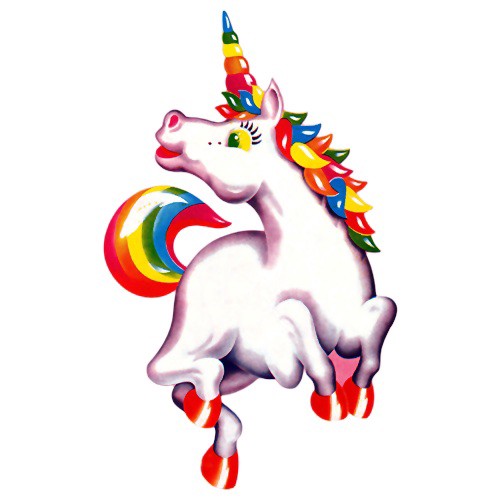
Move over, ordinary pig, cat and dog — a Lisa Frank unicorn would just shut down the use of any other animal Emoji with its rainbow color palette alone. There’s a reason why only carried our art creations from Kindergarten in Lisa Frank folders.
3. Tamagotchi

We mean… why wouldn’t you want a Tamagotchi Emoji? It’s only the best toy of the 90s and think of how great it would be to share the joy of a Tamagotchi over text.
4. Pikachu

You could have a happy Pikachu, sad Pikachu, mad Pikachu, surprised Pikachu… wouldn’t this be 100x better than the cat Emoji faces?
5. ‘Sister, Sister’

Can we get a petition going to replace those two little girls holding hands with Tia and Tamera Mowry?! Nothing screams sisterhood more than one of our favorite set of twins from the 90s!
6. Fuzzy pen
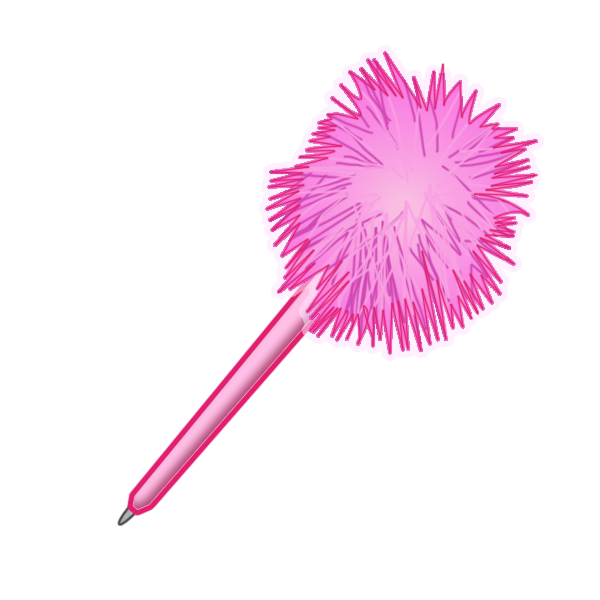
Let’s upgrade that super boring calligraphy pen Emoji with a fluffy pink fuzzy pen in honor of ‘Clueless’ and its incredible influence on our upbringing.
7. Daria

One of our most overused Emojis is the one that looks bored — like this -_-. If we had Daria’s unamused face as an Emoji, we’d be set every time someone made an unnecessary jab at our expense. Plus, this new bored Emoji would have glasses too!
8. Nickelodeon slime

Yeah, it’s random, but having some quintessential Nickelodeon slime as an Emoji could only produce good vibes. How much more did you love your favorite celebrity when he or she got slimed? Think of it as an Emoji that conveys deep, deep affection for the other party.
9. Fresh Prince of Bel-air

Now, this is a story all about how Will Smith got turned into an Emoji…and we liked it. We’re all about Will sitting on a golden throne with some 90s shades on, because we’ve overused our “cool” Emoji wearing the Ray-bans.
As you can see, taking some steps back isn’t always a bad thing — it can be freaking awesome! Head back in time with VH1’s new series Hindsight, which depicts what happens when one girl gets transported back to a decade filled with VHS tapes and crunchy hair spray with the opportunity to do things over.
Tune-in to Hindsight, January 7 + 10/9c on VH1!
The Best Shortreads Of 2014

I used to have misgivings about year-end lists, finding them somewhat self-aggrandizing and maybe even a little desperate, particularly in cases where publications resurfaced their own previous work as if it were some special secret that your having missed upon its original appearance resulted in your becoming desperately deficient in cultural cachet. That said, what with the ever-increasing abundance of content on the Internet in our wonderful data-driven era there is a convincing case to be made that readers are unlikely to have seen the things that might be meaningful to them over the course of the day, or month, or year. Still, everyone seems to focus on the more extensive selections from their output. What about the less verbose efforts? Those tiny essays that say so much in so few words? They deserve even more acknowledgment, don’t they? They almost certainly do. In that spirit and without any further explanation I would like to direct you to a collection of the finest shortform essays we published this year on The Awl. Savor them slowly. Who knows when brilliance like this might come along again?
• January found one of our writers in a deeply contemplative mood, perhaps due to the changing of the calendar.
• February brought thoughts of mortality to a yearning scribe.
• March saw a correspondent tackle one of life’s eternal mysteries.
• April came with both showers and questions concerning theology and purpose.
• May produced a premature but prescient assessment of the era.
• In June we received a missive that seemed to indicate a sense of acceptance and resignation over the current condition; a long period of silence was broken by a piece that in its simplicity functioned as both affirmation and continuation.
What a year it has been for brevity! Let’s hope we see more (by which I mean less) like this in 2015. I dream of a world in which everyone shuts the fuck up completely, but in the meantime I will be contented with expressions of writerly thought capped at two or three words max. And now I will be quiet.
The Poet and His Postcards
by Kaveh Akbar
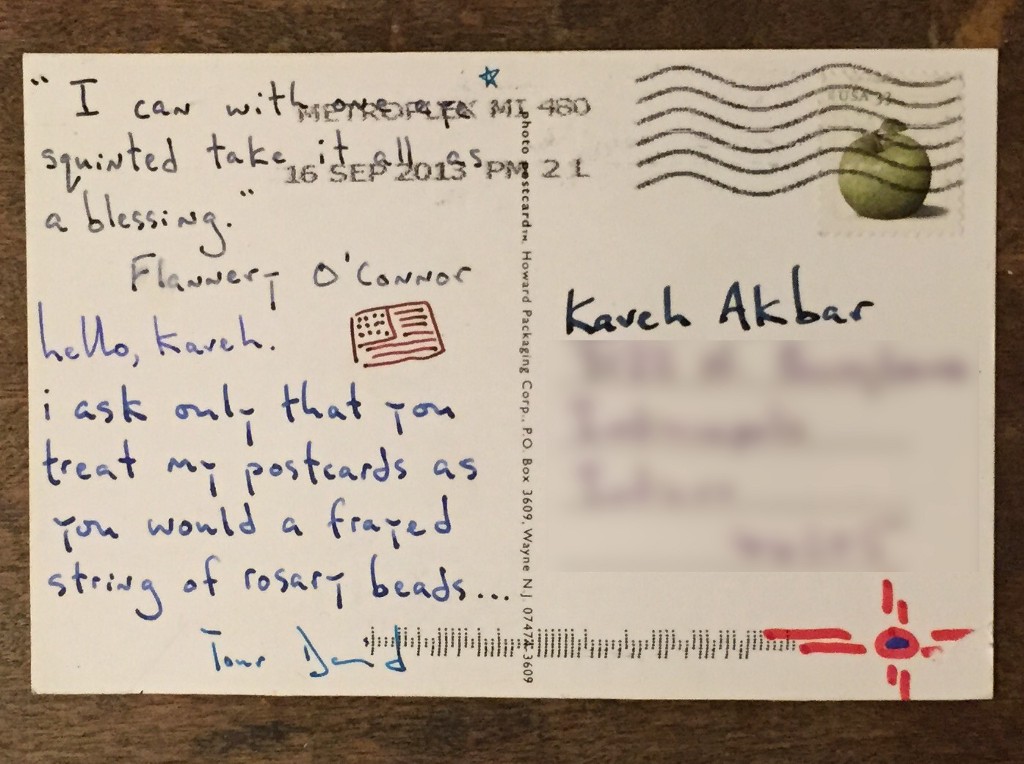
i ask only that you treat my postcards as you would a frayed string of rosary beads…
David J. Thompson has been sending me four or five postcards a week since I was eighteen. I was beginning my undergrad at Purdue, obsessed with small-press poetry the way a child gets obsessed with dinosaurs or construction equipment. He didn’t know me at all, but I knew and loved his poems; they appeared regularly in the little fold-and-staple journals I devoured at the time, magazines like Nerve Cowboy and Staplegun and Barbaric Yawp.
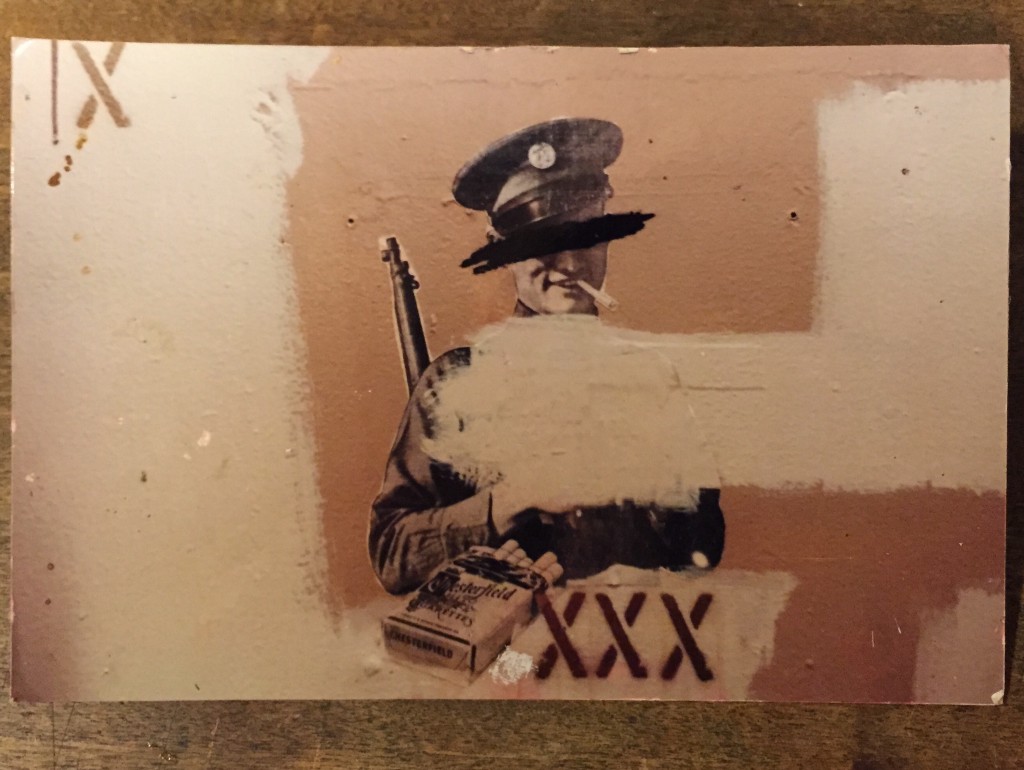
While most writers in that scene were doing bad Bukowski impressions, bumbling around drunken esoteries and humble-bragging about adventures in casual misogyny, Thompson, who lived and taught in a small town near Detroit, wrote poems that were more indebted to William Stafford or Raymond Carver or James Wright. The pieces were rural, domestic, and ribbed with an almost ecstatic desolation. His speakers were down-on-their-luck divorcees, paunchy factory men at their high school reunions, drunk friends marveling over Mexican death masks. I sent him a note saying how much I loved his work; the postcards started arriving soon after, and they’ve never stopped.
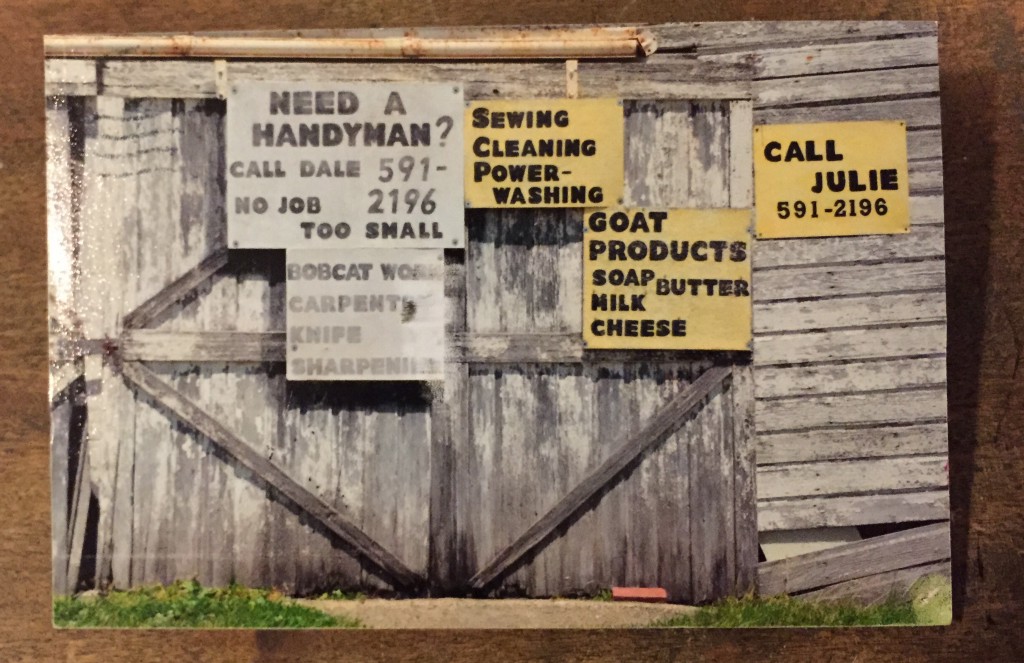
Over the last eight years, I’ve received more than a thousand postcards from David. I’ve read and reread every chapbook he’s published, and we’ve even done a couple readings together. Here’s what I know about him: He’s middle-aged(ish), used to teach high school English, and lives and travels by himself. He loves Criterion films, jazz, and The Simpsons. The bio on his 2009 chapbook It Gets Worse notes that he enjoys “beer and minor league baseball, especially together.” He lists Chet Baker, Robert Capa, and Brooks Robinson as his heroes. A few years ago, he survived cancer after having most of a lung removed. During readings, he stays quiet, typically a huge camera between himself and whatever is happening at the time. One time, at a reading at Notre Dame, still honeymooning with my new ability to drink legally, I got a little brazen with my drink tickets. David quietly slipped me twenty dollars for a taxi, instructed me to have a messy night, then ducked out to drive back home.
But much of his life remains a mystery: Ninety-eight percent of the conversation between us has moved in a single direction, from him to me. I have no idea where he grew up, if he’s ever been married, or if he has kids. He constantly travels around the country, often to famous gravesites (Jimi Hendrix, James Dean, Edna St. Vincent Millay), but I never know where or why he’s going.
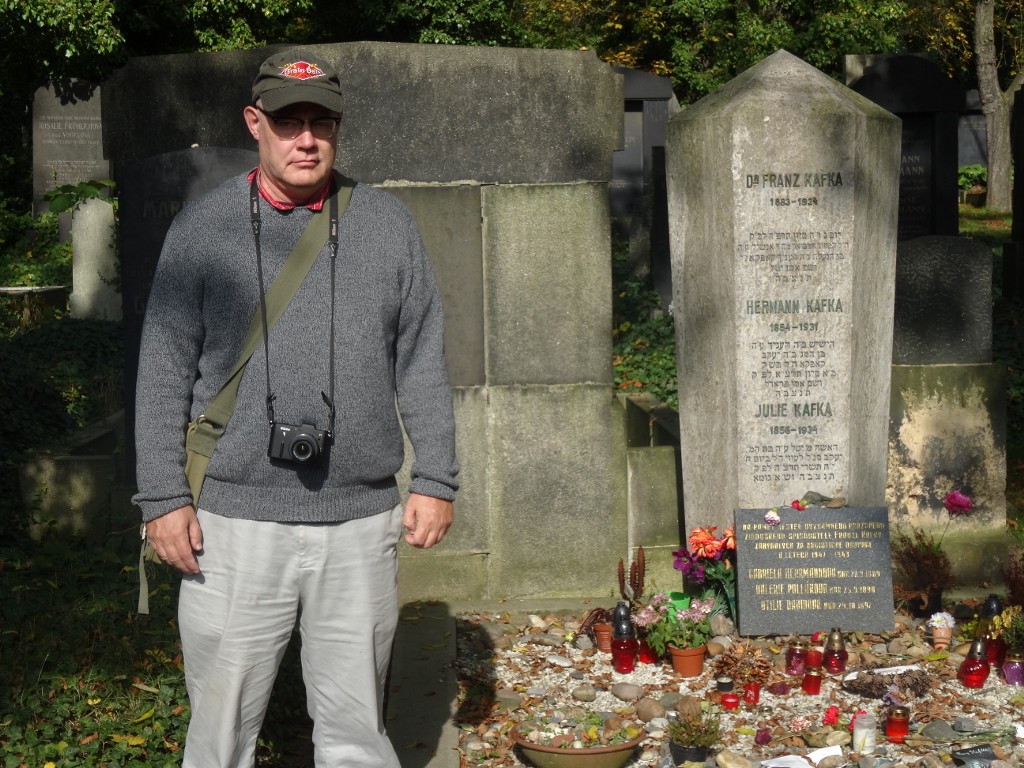
Aside from a modest website for his photography, David doesn’t exist on the internet. He doesn’t have a Twitter or a Facebook or even an Instagram for his photos. As far as I can tell, he channels any documentarian impulses he might have into his art. He takes photos and writes and synthesizes it all into his postcards. I have no idea how many other people get cards from him, but it seems to me that those of us in the exclusive club of postcard recipients are privy to one of the most interesting “social media” streams conceivable — a routinely updated feed of visually striking, intellectually compelling, tactile, personalized content.
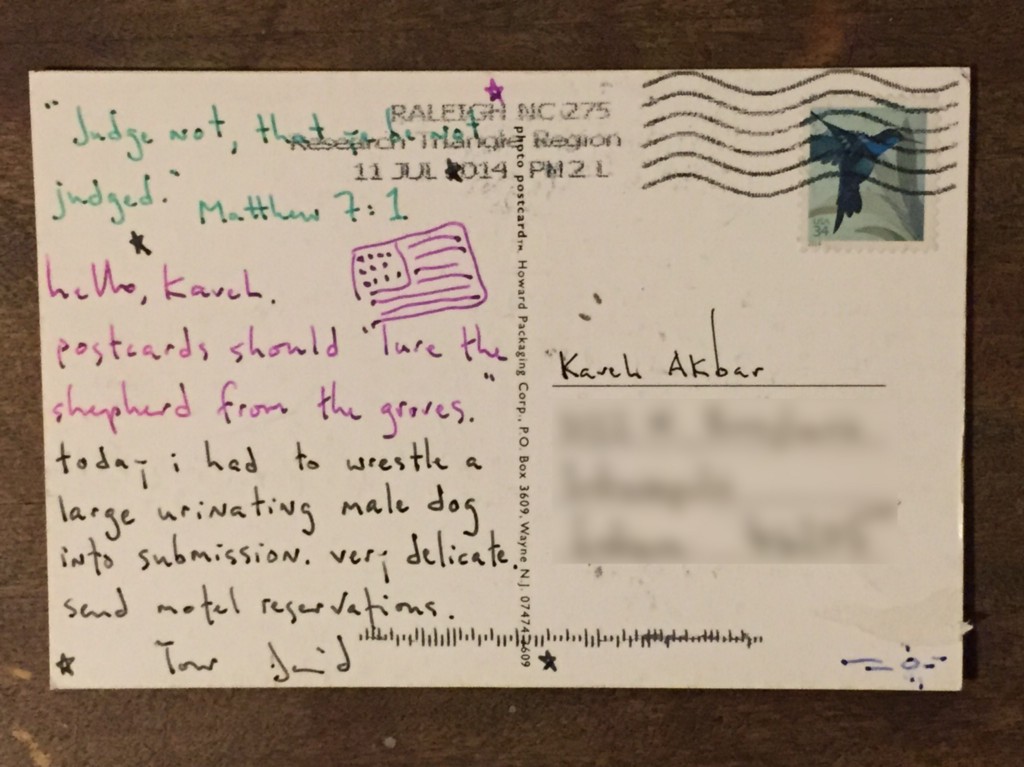
today i had to wrestle a large urinating male dog into submission. very delicate.
A typical David J. Thompson postcard is marked by three features. First is a photo captured from his travels around the country. These scenes deal in a sort of Midwestern gothic aesthetic — dry cornfields filled with gutted machinery, graffiti-covered liquor stores, tattered evangelical billboards, and mossed-over gravestones. Second, on the back, there is a quote from whomever David happens to be reading at the time. His favorites include André Gide (“Time passing here is innocent of hours, yet so perfect is our inoccupation that boredom becomes impossible”); Edmund Gosse (“Beauty and entertainment, we must be bold enough to insist that these come first”); and Thomas Merton (“What I find most in my whole life is illusion”). Finally, there are a few sentences from David to me about his “life.” Usually, these are charmingly fabulist. “i’m dating a woman from a nearby tuberculosis sanitarium. our romance feels rushed, but perhaps for good reason. her cough is insistent.” On another he wrote: “i’ve invested everything i own in a cornish tin mine called wheal maria. let’s hope for the best.” They’re huge in scope, frequently imagining life in a bygone era of European squalor.
This poem began its life as a postcard David sent to me (I wrote him back and insisted that he turn it into a poem).
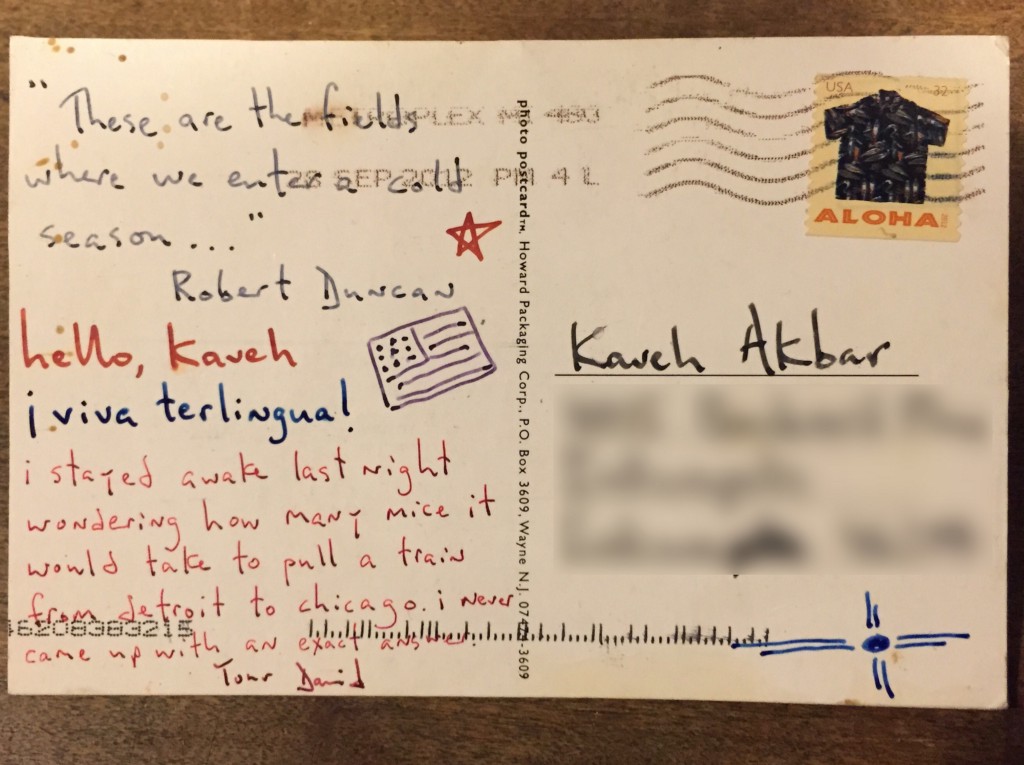
i stayed awake last night wondering how many mice it would take to pull a train from detroit to chicago.
A few weeks ago, I wrote him a quick note to tell him I was thinking about writing an essay about his postcards for The Awl, and he wrote back, saying only: “make me rich and famous.” Barring some miracle, the odds aren’t great. There are no halls in the MoMA dedicated to postcard auteurs. But I see his work every day: in the mailbox, on my walls, in my car, tucked into books, and anywhere else I spend my time.
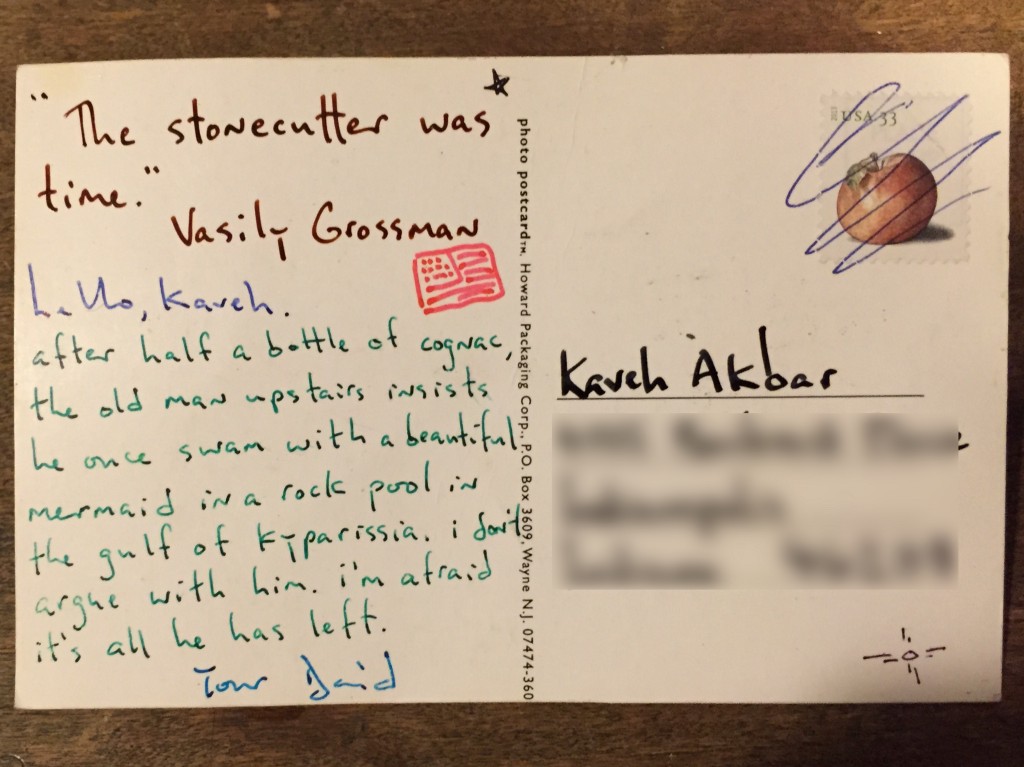
the old man upstairs insists he once swam with a beautiful mermaid in a rock pool in the gulf of kyparissia
